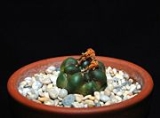
Cintia
Encyclopedia
Cintia knizei is a small alpine cactus
native to the high Andes
of Bolivia
. The plant was discovered by Karel Kníže in 1969 at an elevation of 4,000 m (13,000 ft) near Otavi, in Potosí Department
, Bolivia. However, it was not formally described until 1996 by Jan Říha. The genus is named after the town of Cinti in Chuquisaca Department
.
A solitary plant, it is green, globose, and around 3-5 cm in diameter. The tuber
ous carrot-like roots grow up to 10 cm long. The areole
s are sunken between the podaria
, and are woolly, with no spines. The yellow flower
s occur on the stem tip, and are 3-4 cm in diameter.
It has been proposed to place this cactus in the genus Copiapoa
.
Cactus
A cactus is a member of the plant family Cactaceae. Their distinctive appearance is a result of adaptations to conserve water in dry and/or hot environments. In most species, the stem has evolved to become photosynthetic and succulent, while the leaves have evolved into spines...
native to the high Andes
Andes
The Andes is the world's longest continental mountain range. It is a continual range of highlands along the western coast of South America. This range is about long, about to wide , and of an average height of about .Along its length, the Andes is split into several ranges, which are separated...
of Bolivia
Bolivia
Bolivia officially known as Plurinational State of Bolivia , is a landlocked country in central South America. It is the poorest country in South America...
. The plant was discovered by Karel Kníže in 1969 at an elevation of 4,000 m (13,000 ft) near Otavi, in Potosí Department
Potosí Department
Potosí Department is a department in southwestern Bolivia. It comprises 118,218 km² with 709,013 inhabitants . The capital is the city of Potosí....
, Bolivia. However, it was not formally described until 1996 by Jan Říha. The genus is named after the town of Cinti in Chuquisaca Department
Chuquisaca Department
Chuquisaca is a department of Bolivia located in the center south. It borders on the departments of Cochabamba, Tarija, Potosí, and Santa Cruz. The departmental capital is Sucre, which is also the constitutional capital of Bolivia.-Geography:...
.
A solitary plant, it is green, globose, and around 3-5 cm in diameter. The tuber
Tuber
Tubers are various types of modified plant structures that are enlarged to store nutrients. They are used by plants to survive the winter or dry months and provide energy and nutrients for regrowth during the next growing season and they are a means of asexual reproduction...
ous carrot-like roots grow up to 10 cm long. The areole
Areole
Areoles are an important diagnostic feature of cacti, and identify them as a family distinct from other succulent plants. The areoles on cacti are clearly visible; they generally appear as small light- to dark-colored bumps, out of which grow clusters of spines...
s are sunken between the podaria
Tubercle
A tubercle is generally a wart-like projection, but it has slightly different meaning depending on which family of plants or animals it is used to refer to....
, and are woolly, with no spines. The yellow flower
Flower
A flower, sometimes known as a bloom or blossom, is the reproductive structure found in flowering plants . The biological function of a flower is to effect reproduction, usually by providing a mechanism for the union of sperm with eggs...
s occur on the stem tip, and are 3-4 cm in diameter.
It has been proposed to place this cactus in the genus Copiapoa
Copiapoa
Copiapoa is a genus of cacti from the dry coastal deserts of northern Chile. It comprises about 26 species. These species vary in form from spherical to slightly columnar and in color from a brownish to blue-green body.-Taxonomy:...
.

